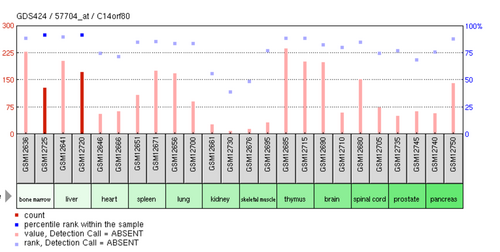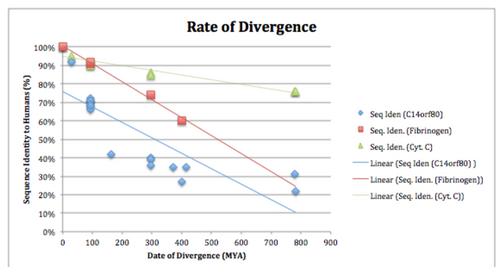Biology:C14orf80
 Generic protein structure example |
Uncharacterized protein C14orf80 is a protein which in humans is encoded by the chromosome 14 open reading frame 80, C14orf80, gene.
Gene
Location
C14orf80 is located on chromosome 14 (14q32.33) starting at 105,489,855bp and ending at 105,499,248bp. C14orf80 is 9,393 base pairs long and contains 11 exons that can be alternatively spliced to form different mRNA variants.[1]
Variants
Transcription of C14orf80 can produce 19 mRNA splice variants. Only six of these nineteen variants are predicted to not encode for a protein.[2] Of the mRNA variants that have been found experimentally, the longest is 1,719 base pairs and produces a protein with 426 amino acids.[3]
Expression
C14orf80 has been determined to be expressed in 77 types of tissues and 100 developmental stages.[4] It has also been determined to have a higher level of expression in a few cases of pancreatic and prostate cancer cells compared to normal tissue.[5]
Homology
Paralogs
There are no paralogs of C14orf80.[6]
Orthologs
Using the BLAST program from NCBI, the orthologs of C14orf80 were found to range from primates to invertebrates. Below is a table that contains a variety of these orthologs.[7]
| Species | Common name | Accession number | Date of divergence | Sequence length (AA) | Sequence similarity |
|---|---|---|---|---|---|
| Homo sapiens | Human | NP_001128347 | 0 mya | 426 | 100% |
| Chlorocebus sabaeus | Green monkey | XP_007986247 | 29 mya | 424 | 94% |
| Ictidomys tridecemlineatus | 13-lined ground squirrel | XP_005334680 | 92.3 mya | 426 | 80% |
| Bos taurus | Cow | XP_003585026 | 94.2 mya | 419 | 78% |
| Rattus norvegicus | Brown rat | XP_002726827 | 92.3 mya | 420 | 76% |
| Zonotrichia albicollis | White-throated sparrow | XP_005493655 | 296 mya | 454 | 53% |
| Pelodiscus sinensis | Chinese softshell turtle | XP_006137260 | 296 mya | 404 | 51% |
| Xenopus tropicalis | Tropical clawed frog | XP_002935771 | 371.2 mya | 437 | 50% |
| Danio rerio | Zebra fish | XP_706561 | 400.1 mya | 452 | 41% |
| Camponotus floridanus | Florida carpenter ant | XP_011255960 | 782.7 mya | 374 | 38% |
Evolution rate
When compared to the slow-evolving cytochrome C gene and the fast-evolving fibrinogen gene, gene C14orf80 is also fast-evolving.[7]
Protein
General properties
Uncharacterized protein C14orf80 is 426 amino acids long with a molecular weight of 47 kDa.[8] Its isoelectric point is 8.9.[9]
Composition
Secondary structure
Uncharacterized protein C14orf80 is predicted to be entirely composed of alpha helices.[10] Using the program SOUSI-signal, it was predicted that uncharacterized protein C14orf80 does not contain a signal peptide and is a soluble protein.[11]
Function
Domains
Uncharacterized protein C14orf80 has two functional domains. The first domain is the domain of unknown function 4509 and the second is the domain of unknown function 4510. As their naming states the functions of these domains are still unknown.[6]
DUF4509 is located at amino acid 45 to amino acid 228. In this domain of unknown function there is a conserved WLL sequence motif.[12]
DUF4510 is located at amino acid 263 to amino acid 425. In this domain of unknown function there are two conserved sequence motifs: LEA and WMD.[13]
Post-translational modification
Uncharacterized protein C14orf80 is predicted to have glycation and phosphorylation sites for post-translational modification. Of these sites three are for glycation, eight are for serine phosphorylation and one site is for threonine phosphorylation.[14][15]
Subcellular location
Uncharacterized protein C14orf80 is not predicted to be a transmembrane protein. It is mainly localized to the golgi apparatus but has been found in the nucleus and cytoplasm also.[16]
Interactions
Currently, there are 21 proteins that are predicted to interact with uncharacterized protein C14orf80. These 21 proteins were found using the databases Mentha,[17] BioGRID,[18] STRING,[19] GeneCards[20] and IntAct.[21] Below is a table of a variety of these 21 proteins.
| Interacting protein | Full protein name | Function | Citation |
|---|---|---|---|
| DDIT3 | DNA-damage inducible transcript 3 | Induces cell cycle arrest and apoptosis when ER stress | [22] |
| CEBPZ | CCAAT enhancer binding protein | Stimulates transcription from HSP70 promoter | [22] |
| UBC | Ubiquitin C | "Methods for quantification of in vivo changes in protein ubiquitination following proteasome and deubiquitinase inhibition". Molecular & Cellular Proteomics 11 (5): 148–59. May 2012. doi:10.1074/mcp.M111.016857. PMID 22505724. | |
| FKBP5 | FK506 binding protein | Immunophilin protein with PPIase | "A quantitative chaperone interaction network reveals the architecture of cellular protein homeostasis pathways". Cell 158 (2): 434–448. July 2014. doi:10.1016/j.cell.2014.05.039. PMID 25036637. |
| DEF107A | Beta-defensin 107 | Anti-bacterial activity | [23] |
| XAGE1D | Cancer/testis antigen family 12 member 1D | [24] | |
| TRAK2 | Trafficking protein kinesin binding 2 | May regulate endosome to lysosome trafficking of membrane cargo | [25] |
| NRF1 | Nuclear respiratory factor 1 | Transcription factor on nuclear genes encoding respiratory subunits and components of the mitochondrial transcription and replication machinery | [26] |
Clinical significance
Uncharacterized protein C14orf80 has been associated with tumors in the breast, CNS, endometrium, large intestine, lung, skin, and stomach.[27]
References
- ↑ https://www.ncbi.nlm.nih.gov/gene/283643>
- ↑ "Summary - Homo sapiens - Ensembl genome browser 97". http://www.ensembl.org/Homo_sapiens/Transcript/Summary?db=vega;g=OTTHUMG00000170426;r=14:105491268-105499209;t=OTTHUMT00000074613.
- ↑ "Homo sapiens tubulin epsilon and delta complex 1 (TEDC1), transcript variant 1, mRNA". 2018-12-04. https://www.ncbi.nlm.nih.gov/nuccore/NM_001134875.1.
- ↑ "Bgee - Gene: C14orf80 - ENSG00000185347 - Homo sapiens (human)". http://bgee.unil.ch/bgee/bgee?page=gene&action=summary&gene_id=ENSG00000185347.
- ↑ "Home - GEO Profiles - NCBI". https://www.ncbi.nlm.nih.gov/geoprofiles.
- ↑ 6.0 6.1 "TEDC1 Gene - GeneCards | TEDC1 Protein | TEDC1 Antibody". https://www.genecards.org/cgi-bin/carddisp.pl?gene=C14orf80.
- ↑ 7.0 7.1 "Basic local alignment search tool". Journal of Molecular Biology 215 (3): 403–410. October 1990. doi:10.1006/jmbi.1990.9999. PMID 2231712.
- ↑ "The Biology Workbench--a seamless database and analysis environment for the biologist". Proteins 32 (1): 1–2. July 1998. doi:10.1002/(sici)1097-0134(19980701)32:1<1::aid-prot1>3.0.co;2-q. PMID 9672036.
- ↑ "Reference points for comparisons of two-dimensional maps of proteins from different human cell types defined in a pH scale where isoelectric points correlate with polypeptide compositions". Electrophoresis 15 (3–4): 529–539. 1994. doi:10.1002/elps.1150150171. PMID 8055880.
- ↑ "Methods and algorithms for statistical analysis of protein sequences". Proceedings of the National Academy of Sciences of the United States of America 89 (6): 2002–2006. March 1992. doi:10.1073/pnas.89.6.2002. PMID 1549558. Bibcode: 1992PNAS...89.2002B.
- ↑ Gomi, M.; Sonoyama, M.; Mitaku, S. (2004). "High performance system for signal peptide prediction: SOSUIsignal". Chem-Bio Informatics Journal 4 (4): 142–147. doi:10.1273/cbij.4.142.
- ↑ "Pfam: Family: DUF4509 (PF14970)". http://pfam.xfam.org/family/PF14970#tabview=tab0.
- ↑ "Pfam: Family: DUF4510 (PF14971)". http://pfam.xfam.org/family/PF14971.
- ↑ "NetGlycate 1.0 Server". http://www.cbs.dtu.dk/services/NetGlycate/.
- ↑ "NetPhos 3.1 Server". http://www.cbs.dtu.dk/services/NetPhos/.
- ↑ "Cell atlas - C14orf80 - the Human Protein Atlas". http://www.proteinatlas.org/ENSG00000185347-C14orf80/subcellular.
- ↑ "mentha: a resource for browsing integrated protein-interaction networks". Nature Methods 10 (8): 690–691. August 2013. doi:10.1038/nmeth.2561. PMID 23900247. https://zenodo.org/record/924817.
- ↑ "BioGRID: a general repository for interaction datasets". Nucleic Acids Research 34 (Database issue): D535–D539. January 2006. doi:10.1093/nar/gkj109. PMID 16381927.
- ↑ "STRING v10: protein-protein interaction networks, integrated over the tree of life". Nucleic Acids Research 43 (Database issue): D447–D452. January 2015. doi:10.1093/nar/gku1003. PMID 25352553.
- ↑ "GeneCards Version 3: the human gene integrator". Database 2010: baq020. August 2010. doi:10.1093/database/baq020. PMID 20689021.
- ↑ "The MIntAct project--IntAct as a common curation platform for 11 molecular interaction databases". Nucleic Acids Research 42 (Database issue): D358–D363. January 2014. doi:10.1093/nar/gkt1115. PMID 24234451.
- ↑ 22.0 22.1 "Network organization of the human autophagy system". Nature 466 (7302): 68–76. July 2010. doi:10.1038/nature09204. PMID 20562859. Bibcode: 2010Natur.466...68B.
- ↑ "High-resolution comparative genomic hybridization of inflammatory breast cancer and identification of candidate genes". PLOS ONE 6 (2): e16950. February 2011. doi:10.1371/journal.pone.0016950. PMID 21339811. Bibcode: 2011PLoSO...616950B.
- ↑ "Construction and characterization of a normalized yeast two-hybrid library derived from a human protein-coding clone collection". BioTechniques 44 (2): 265–73. February 2008. doi:10.2144/000112674. PMID 18330356.
- ↑ High-Throughput Proteomic Mapping of Human Interaction Networks via Affinity-Purification Mass Spectrometry (Report).
- ↑ "Pathway Analysis of ChIP-Seq-Based NRF1 Target Genes Suggests a Logical Hypothesis of their Involvement in the Pathogenesis of Neurodegenerative Diseases". Gene Regulation and Systems Biology 7: 139–52. 2013. doi:10.4137/GRSB.S13204. PMID 24250222.
- ↑ "Phenotypes - Homo sapiens - Ensembl genome browser 97". http://www.ensembl.org/Homo_sapiens/Gene/Phenotype?db=vega;g=OTTHUMG00000170426;r=14:105491268-105499209;t=OTTHUMT00000074610.
 |





